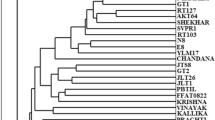Abstract
Genetic variation among 15 accessions of Native American maize from the Great Plains was investigated using random amplified polymorphic DNA (RAPD). RAPDs revealed very high levels of polymorphism among accessions. Banding patterns ranged in percentage polymorphism from 46.7% to 86.2% with an overall mean of 70.7% for the primers analyzed. The construction of genetic relationships using cluster analysis and principal coordinates analysis revealed that RAPDs are successful in confirming hypothesized relationships and in identifying misclassified specimens. Furthermore, the phenogram fails to reveal a strong correspondence between genetic relationships and the geographical position of Native Americans prior to contact. This provides support for the hypothesis that multiple introductions of maize into the Great Plains via trade may have resulted in the great morphological variation found among accessions in the region. Based on these data, it is unlikely that a separate Great Plains race of maize can be distinguished. In general, we conclude that RAPDs are potentially very useful in organizing seed collections and understanding intraspecific genetic differentiation.
Similar content being viewed by others
Author information
Authors and Affiliations
Additional information
Received: 10 March 1999 / Accepted: 25 March 1999
Rights and permissions
About this article
Cite this article
Moeller, D., Schaal, B. Genetic relationships among Native American maize accessions of the Great Plains assessed by RAPDs. Theor Appl Genet 99, 1061–1067 (1999). https://doi.org/10.1007/s001220051415
Issue Date:
DOI: https://doi.org/10.1007/s001220051415




